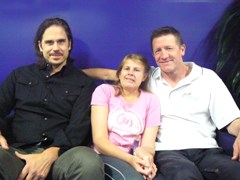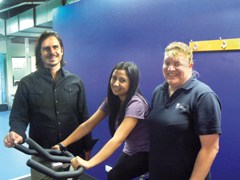02 April 2012
 An exercise and physical activity program developed by the University of South Australia for children with cancer has helped about 30 South Australian children improve their health and well-being.
An exercise and physical activity program developed by the University of South Australia for children with cancer has helped about 30 South Australian children improve their health and well-being.
The Little Heroes Foundation Child Family Care Project, a collaboration between the Little Heroes Foundationand UniSA’s School of Health Sciences and facilitated by the Leukaemia Foundation, resulted in physical health, mental health and quality of life benefits for children aged five to 18, who were off-treatment and not undergoing chemotherapy while undertaking the 10-week program.
UniSA’s Human Movement Program Director, Dr Maarten Immink, says each child had an appropriate evidence-based exercise program tailored to their individual needs by tertiary-trained clinical exercise physiologists.
“Research has shown that for adults who have gone through cancer and had treatment, being active has meant their chance of relapse is reduced,” Dr Immink says.
“The old thinking is that for anyone with cancer or other diseases we should avoid physical activity. But the evidence now is quite the opposite. An appropriate level of exercise has benefits for the immune system, physical health, mental health, and well-being across the board.
“While research into exercise for childhood cancer is currently under-studied, existing evidence supports the idea that exercise provides benefits for children with cancer and consistent with this, in our pilot program, we certainly had encouraging results.”
Dr Immink says the project was unique in that an Accredited Exercise Physiologist, a recognised allied health professional specialising in exercise for chronic and complex diseases, delivered the exercise intervention.
“To this extent, the project was successful in that the professional was able to take into consideration and accommodate the specific needs of the individual participant and their condition. The importance of this is that all children were able to safely participate in physical activity and also enjoy the progress they made,” he says.
Exercise programs for children aged six to 10 focused on game-based activities, while the programs for older children were gym-based, including resistance training and aerobic training. Human Movement Lecturer Dr Carmel Nottle says the primary aim of the program was to instil a perception of exercise and physical activity-related enjoyment, self-efficacy and benefits. The secondary aim was to achieve health and quality of life-related clinical outcomes to meet individual needs.
Human Movement Lecturer Dr Carmel Nottle says the primary aim of the program was to instil a perception of exercise and physical activity-related enjoyment, self-efficacy and benefits. The secondary aim was to achieve health and quality of life-related clinical outcomes to meet individual needs.
“Some of the children had delayed development because of their cancer treatment, while some had the concern of being overweight because they hadn’t had the chance to be active as kids naturally or take part in organised sport,” she says.
“For the younger kids, some hadn’t had the chance to properly develop their motor skills. Others had ongoing issues from cancer and surgery, so there was a rehabilitation component as well as the education component on how to be active. What we saw in terms of results was heartening. All the children who took part had an improvement. Most of it was fitness-related, but a lot of it was also about their self-esteem, feeling that they can exercise, thinking about how they can be involved in sport and feeling like they’re ready to go back to that, and confidence in themselves.”
Little Heroes Foundation Director Chris McDermott says: “I cannot speak highly enough of the work UniSA’s School of Health Sciences has done in helping develop this program as a vital part of our Child Family Care Services. The benefit to the children that have been through the program has been truly amazing in a variety of ways and we look forward to even more positive outcomes in 2012.”
Lina Kontogonis is one parent who saw remarkable results from the program. Her daughter Sophia is one of the participants for whom the program had a hugely positive impact. Diagnosed with bone cancer in her left thigh in 2007, Sophia underwent 10 months of intensive chemotherapy and numerous operations including removing 10cm of bone from her leg. She remained in a wheelchair for many months and eventually on crutches for years.
“The program has assisted Sophia greatly not only physically but also psychologically,” Lina says.
“The exercises designed especially for her circumstance led to her leg and bones becoming much stronger so she can now walk very confidently, without crutches, despite complications with this leg. She now has a love for long walks and she regularly attends Zumba classes. We have seen a great improvement in her self-esteem and her overall confidence and she is now a more outgoing person. She has become involved in many tasks, sports and social activities which previously she was limited to or perhaps she was not confident enough to attempt. Her total outlook on life has improved as a result of this program.”
More information about UniSA’s School of Health Sciences Exercise Physiology Clinic can be found athttp://www.unisa.edu.au/hls/what_we_do/clinics/exercise.asp
Media contact
- Kelly Stone office (08) 8302 0963 mobile 0417 861 832 email kelly.stone@unisa.edu.au


